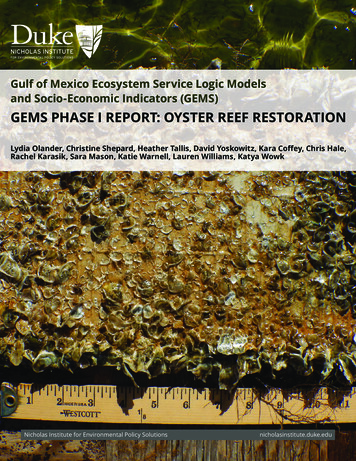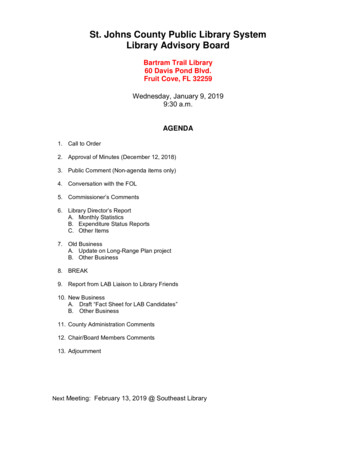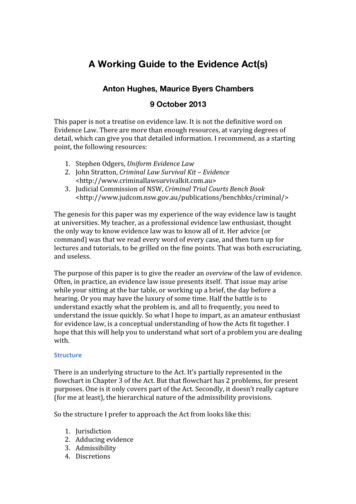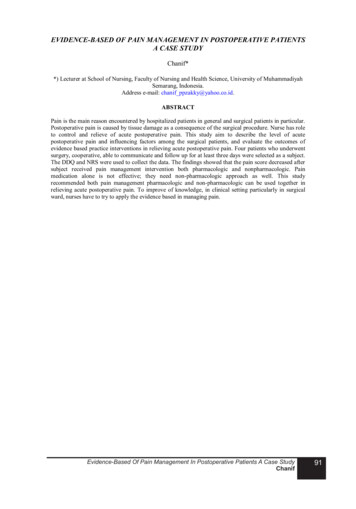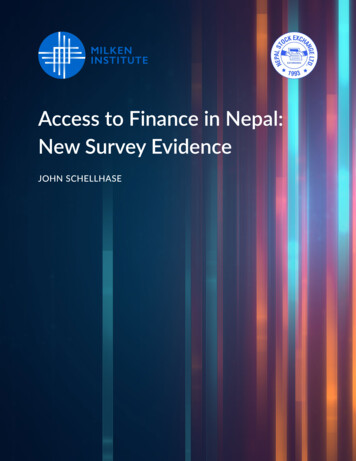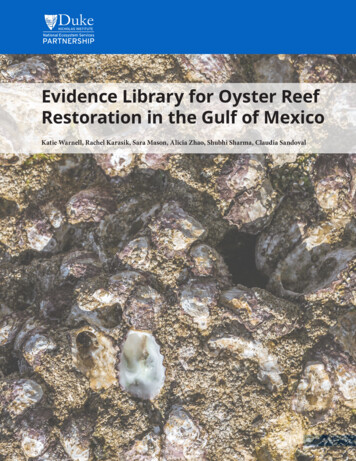
Transcription
DukeNICHOLAS INSTITUTENational Ecosystem ServicesPARTNERSHIPEvidence Library for Oyster ReefRestoration in the Gulf of MexicoKatie Warnell, Rachel Karasik, Sara Mason, Alicia Zhao, Shubhi Sharma, Claudia Sandoval1
Evidence Library for Oyster Reef Restoration in the Gulf of Mexicohttp://bit.ly/NI-ESKatie Warnell, Rachel Karasik, Sara Mason,Alicia Zhao, Shubhi Sharma, Claudia SandovalINTRODUCTIONBillions of dollars will be spent on large-scalerestoration of Gulf ecosystems over the comingdecades, but there is no shared platform toguide assessment and reporting of restorationprogress and effectiveness for the broad setof environmental, social, and economic goalsshared by the many institutions working in theGulf. The diversity of these goals—includinghabitat restoration, water quality improvement,marine resource protection, communityresilience, and economic revitalization—means that a variety of metrics are needed tofully evaluate the effectiveness of restorationprojects. The GEMS (Gulf of MexicoEcosystem Service Logic Models and SocioEconomic Indicators) project aims to advancestandardized metrics of restoration successby developing ecosystem service logic models(ESLMs) with stakeholders from the five Gulfstates, relevant federal agencies, and technicalexperts. ESLMs trace the effects of restorationstrategies as they influence ecological andsocial systems to create outcomes that areimportant to people. The use of logic modelsis recommended by the National Academiesof Science as best practice for monitoring plandesign; these models can provide a practicaland transferable approach for measuringsuccess at different scales.information on the GEMS process, see theOyster Reef Restoration Report). The generalESLM is not tied to any particular oyster reefrestoration technique but represents all of theoutcomes from oyster reef restoration thatare dominant—large, tightly linked to oysterreef restoration, and important to the localcommunity. The model shows the cascadeof changes that restoration (dark blue box)causes in the biophysical and social systems(gray boxes), leading to effects on commonlymeasured ecological components (green boxes),human activity outcomes (light blue boxes),and socioeconomic outcomes (yellow boxes).Downloadable pdf and editable versions ofthe general ESLM, as well as specific versionsof the ESLM for each oyster reef restorationtechnique, are available on the GEMS website.The evidence library starting on page fivecontains summaries of the evidence for each ofthe links in the general oyster reef restorationESLM (Figure 1). Summaries include anassessment of the strength of evidence foreach link; links in Figure 1 are color-codedby strength of evidence rating. Each link inthe model has an identification number. Tofind the evidence library entry for a particularlink, you can click on the link number on theconceptual model figure or use the searchfunction (keyboard shortcut Control F) andsearch for “Link #” (e.g., “Link 3”).ECOSYSTEM SERVICE LOGIC MODELFOR OYSTER REEF RESTORATIONThe general ESLM for oyster reef restoration(Figure 1) was developed through a multistepprocess with input from oyster restorationexperts and local stakeholders as wellas through a literature review (for more2
Figure 1. Ecosystem Service Logic Model for Oyster Reef Restoration, Links Color-Coded By Strength of EvidenceRating. Numbers Correspond to Sections Below.3
In the ESLM, pathways consist of links that connect the intervention (left) to a socioeconomicoutcome (right). Major pathways are those where socioeconomic outcomes are tightly linked tooyster reef restoration (ORR) (i.e., there is a possibility that the outcome would show a noticeablechange given an ORR project) (Figure 2). Each link in a major pathway has a moderate to highstrength of evidence rating, is considered attributable to ORR (or has few “Other Factors”), andis considered significant based on the evidence and stakeholder input. We highlight five majorpathways linking the intervention to the following outcomes: Adjacent habitat (which can have a range of additional outcomes and can be exploredthrough the ESLMs for these other habitats); Economic activity in the fishing and oyster harvest industry through oyster harvest(Note: this pathway includes a feedback loop between intermediate outcomes “Oysterpopulation” and “Oyster harvest techniques.” Higher oyster populations in an area canresult in increased harvest limits (or new areas open to harvest) and greater use of oysterharvest techniques. Oyster harvest in turn decreases oyster populations and generateseconomic activity through oyster sales.) Economic activity in the fishing and oyster harvest industry though non-oyster (fish,other shellfish, etc.) harvest; Economic activity through the restoration industry; and Education4
Figure 2. Ecosystem Service Logic Model for Oyster Reef Restoration, Links Color-Coded by Major Pathways.Numbers Correspond to Sections Below.5
EVIDENCE LIBRARY FOR OYSTER REEF RESTORATION ESLMThe evidence for each link in the oyster reef restoration ESLM (Figure 1) is summarized below.Each evidence summary has the following components:Description of RelationshipShort description of the relationship between the starting and ending nodes (boxes), based on theevidence found.Summary of EvidenceOverview of the evidence found to support the relationship, including the types of methods used,geographic location, applicability to the Gulf of Mexico context, and major conclusions.Strength of EvidenceRating of the overall strength of evidence for the relationship, based on the following criteria,with a short explanation.ConfidencelevelCriteriaTypes of evidenceConsistency ofresultsMethodsApplicabilityHighMultipleDirection andmagnitudeof effects areconsistent acrosssources, typesof evidence, andcontextsWell-documented andacceptedHighModerateSeveralSome consistencySome documentation, not Somefully acceptedFairA fewLimitedconsistencyLimited documentation,emerging tPoor documentation oruntestedLimited tononeNoneNoneN/AN/AN/AOther FactorsList of external factors (including biophysical, ecological, and social factors) that influencethe relationship between the starting and ending nodes (boxes), how each factor affects therelationship, and the magnitude of the effect, if known.PredictabilityEvaluation of how predictable a change in the ending node is, given a certain change in thestarting node. For example, the relationship between the two nodes may be unpredictable due toinfluences from external factors or gaps in scientific knowledge. Any models or tools designed topredict the relationship are noted.SourcesList of sources for the evidence for this relationship.6
Link 1: Planting New or Restoring Existing Oyster Reef Oyster Reef Quantity orQualityDescription of RelationshipMost oyster reef restoration projects directly change the quantity or quality of oyster reefs byadding substrate material. Projects aimed at protecting and enhancing existing reefs may addmaterial or protect reefs so that natural processes that cause reef expansion and other attributechanges can occur.Summary of EvidenceThe six oyster reef restoration techniques considered in this project represent four majorcategories in terms of their effect on oyster reef quantity or quality; these four categories areaddressed separately in this summary.Placement of oyster substrate to create structurally simple reefs (Technique 1): These projectsplace loose cultch material (usually oyster shells, relic shells, crushed limestone, or crushedconcrete) on the estuary floor to create a flat or “two-dimensional” structure on which oysterscan grow. Monitoring reports from oyster restoration sites in Louisiana and Florida confirm thatcultch placement projects increase the extent of oyster substrate (Louisiana Natural ResourceTrustees 2016, NRDA 2017). However, these reefs are designed to recruit a single age class ofoysters; when these oysters are harvested, the majority of oysters on the reef are removed andthe reef structure is substantially damaged (for more detail on the effects of harvesting on oysterreef quantity and quality, see Link 29). Field research and modeling show that low reefs exposeoysters to poor environmental conditions, resulting in a less healthy oyster community, and aresusceptible to burial by sediment, decreasing their long-term viability (Jordan-Cooley et al. 2011;Schulte et al. 2009).Placement of oyster substrate to create structurally complex reefs (Techniques 2, 3, and 4): Theseprojects place large, durable materials (e.g., oyster balls, precast concrete structure, large piecesof limestone) to create a three-dimensional structure to which oysters can attach. The resultingoyster reef has a significant vertical component, resulting in a healthier oyster community due toexposure to better environmental conditions, and is less likely to be buried by sediment (JordanCooley et al. 2011; Schulte et al. 2009). These projects can be placed in subtidal or intertidal areasand can be open or closed to harvest (see Link 29 for discussion of harvesting effects on oysterreef quantity and quality). Metrics related to reef height and structural complexity are not oftencollected or made available, making it difficult to assess the long-term influence of projects onreef quantity and quality (La Peyre et al. 2014; Appendix A). A field survey of subtidal oysterrestoration projects in the Gulf of Mexico found that rock reefs had greater volumes (liters/m2,indicating higher vertical relief or more complexity) than shell or historic reefs (La Peyre et al.2014). Intertidal projects, often referred to as “living shoreline” projects, often use vertical relief ofthe reef as a key monitoring metric (e.g., NOAA Restoration Center 2016).Protection or enhancement of existing reefs (Technique 5): Protection of existing reefs(preventing intensive oyster harvest) does not directly change reef extent or structure. Dependingon system dynamics (including oyster growth rates, disease, and other stressors), protectedreefs may accumulate material and grow in extent, height, and complexity. An analysis of oysterstock assessment data in the Delaware Bay estimated the minimum doubling time of oyster shellmaterial on oyster beds at 10–25 years, assuming zero shell loss (Powell et al. 2006). This indicatesthat oyster reefs can grow naturally when shell loss (caused either by environmental conditions or7
anthropogenic actions) is low, although the authors note that there are few documented examplesof reef vertical or lateral expansion. A model of shell accumulation in Mid-Atlantic estuariesshowed that reef accretion only occurs when oyster populations are high and harvest rates are low(Powell et al. 2012). When protection of existing reefs is combined with habitat enhancement byplacing substrate material (e.g., Walton Lab, n.d.), the effect on reef extent and structure dependson the material used, as described above for the creation of structurally simple and structurallycomplex reefs.Oyster aquaculture projects (Technique 6): The oyster aquaculture methods used in the Gulf ofMexico are “off-bottom”—oysters are grown in baskets or cages suspended in the water column(Walton n.d.). Therefore, oyster aquaculture does not create a natural reef structure, but it doescreate a new population of oysters in the estuary system that perform certain ecological functionssimilar to natural oyster populations (see Link 40 and links resulting from oyster population).Strength of EvidencePlacement of oyster substrate to create structurally simple reefs or structurally complex reefs:Moderate. While the short-term effect of a project on the extent and structure of oyster reefs isevident from project plans, longer-term persistence of the created reefs is uncertain, and there islimited monitoring data available for established reef projects.Protection or enhancement of existing reefs: Low. There is little evidence to support the idea thatreef protection alone will result in reef accretion or lateral expansion, and environmental factorsplay a strong role in determining shell accretion rates (Powell et al. 2012). When protection iscombined with reef enhancement by substrate placement, the short-term effect on reef size andstructure is straightforward, but persistence of this effect is uncertain.Oyster aquaculture: High. Oyster aquaculture creates and maintains oyster populations inbaskets or cages with known dimensions and locations.Other FactorsEnvironmental factors (salinity, dissolved oxygen, sedimentation rates) that influence the healthand growth of oyster populations affect the timeframe on which the oyster reefs created byrestoration projects persist.Oyster disease: Modeling of oyster shell budgets in the Mid-Atlantic suggests that oyster reefaccretion is not possible in areas where dermo and other oyster diseases are prevalent (Powell etal. 2012).PredictabilityThe immediate effect of restoration projects that involve placing substrate on oyster reef quantityand quality is described in project planning documents (extent, shape, and relief of substrate).Longer term effects of these projects, as well as protection of existing reefs, is dependent on avariety of factors and difficult to predict.SourcesLouisiana Natural Resource Trustees. 2016. “Louisiana Oyster Cultch Project: NRDA EarlyRestoration Project Comprehensive Final Monitoring Report.” mprehensive%20Final LA%20Oyster%20Cultch%20Project 2016%2005%2009.NRDA. 2017. “Florida Oyster Cultch Placement Project.”. 2017.8
Jordan-Cooley, W.C., R.N. Lipcius, L.B. Shaw, J. Shen, and J. Shi. 2011. “Bistability in aDifferential Equation Model of Oyster Reef Height and Sediment Accumulation.” Journalof Theoretical Biology 289 (November 21): 1–11. , D.M., R.P. Burke, and R.N. Lipcius. 2009. “Unprecedented Restoration of a Native OysterMetapopulation.” Science 325, no. 5944 (August 28): 1124–28. https://doi.org/10.1126/science.1176516.La Peyre, M., J. Furlong, L.A. Brown, B.P. Piazza, and K. Brown. 2014. “Oyster Reef Restorationin the Northern Gulf of Mexico: Extent, Methods and Outcomes.” Ocean & CoastalManagement 89 (March 1): 20–28. AA Restoration Center. 2016. “Monitoring Plan for DWH NRDA Early Restoration Project:Swift Tract Living Shoreline.”Powell, E.N., J.M. Klinck, K. Ashton-Alcox, E.E. Hofmann, and J. Morson. 2012. “The Rise andFall of Crassostrea Virginica Oyster Reefs: The Role of Disease and Fishing in TheirDemise and a Vignette on Their Management.” Journal of Marine Research 70(2–3): 505558. 8.Powell, E.N., J.N. Kraeuter, and K.A. Ashton-Alcox. 2006. “How Long Does Oyster Shell Laston an Oyster Reef?” Estuarine, Coastal and Shelf Science, Salt Marsh Geomorphology:Physical and Ecological Effects on Landform, 69, no. 3 (September 1): 531–42. https://doi.org/10.1016/j.ecss.2006.05.014.Walton Lab. n.d. “Oyster Reserve Establishment in Mississippi Sound.” http://www.auburn.edu/ ve-establishmen.html.Walton, W. n.d. “Growing the Oyster Aquaculture Industry in the Gulf of Mexico.”Link 2: Planting New or Restoring Existing Oyster Reef Economic Activity(Restoration)Description of RelationshipOyster restoration directly supports jobs related to project planning and construction.Summary of EvidenceRestoration projects that involve placing oyster substrate or constructing oyster aquaculturefacilities involve many types of jobs, from project planning and materials preparation toconstruction and piloting vessels. An extensive list of more than 40 jobs essential to oyster reefrestoration, drawn from the Bureau of Labor Statistics list of job titles, was developed throughconversations with contractors who oversee oyster restoration projects (Stokes et al. 2012).Not every oyster restoration project will require all of these jobs, and a single oyster restorationproject may not create enough work that new hiring is required. Many of the businesses involvedin oyster reef restoration are small and use short-term workers or subcontractors to meet projectrequirements rather than hiring new permanent staff, but this may change as the magnitude ofoyster reef restoration increases (Stokes et al. 2012). Some jobs needed for restoration projectsrequire a certification or license, which can make it difficult to find qualified employees; thishighlights a need for workforce training (Oxfam America and The Nature Conservancy 2012).A 2015 review of the economic impact of ecological restoration examined 14 case studies ofrestoration projects and found that for every 1 million invested in restoration, between 6 and40 jobs were created. Two of the case studies were for oyster reef restoration projects; theycreated 16.6 and 20.5 jobs per 1 million invested (BenDor et al. 2015a). One of these casestudies, an economic assessment of two oyster restoration projects in Mobile Bay, Alabama,9
estimated that 88 part- and full-time jobs would be supported by reef construction activitiesduring the construction period (approximately 1 year): 9 in project design and management,68 in construction, 8 in monitoring, and 2 in community outreach, workforce development,and marketing (Kroeger 2012). A study of the economic impact of American Recovery andReinvestment Act projects administered by NOAA found that habitat restoration projects created17 jobs for every 1 million invested (Edwards et al. 2012). Five oyster restoration projects wereincluded in the analysis and created an average of 16.6 jobs for every 1 million invested.A national assessment of the economic impact of restoration activities in the United States,carried out by surveying businesses engaged in restoration work, estimated that restorationactivity directly employs about 126,000 people (BenDor et al. 2015b). This study did not reportemployment by businesses engaged in oyster reef restoration separately.Strength of EvidenceHigh. There is clear evidence that oyster reef restoration projects support a variety of jobs duringthe planning and construction phases. Economic assessments, including several assessmentsof oyster restoration projects in the Gulf of Mexico, have estimated the number of jobs directlysupported by individual projects.Other FactorsThe specific plans for individual projects determine the types of jobs that are needed and the timeframe over which jobs are supported.PredictabilityGeneral predictions for the number of jobs supported by a particular project could be made basedon the total project cost, using the numbers provided above for job creation from restorationprojects; however, there are few estimates available for oyster restoration specifically, so any suchpredictions would be highly uncertain.SourcesBenDor, T.K., A. Livengood, T.W. Lester, A. Davis, and L. Yonavjak. 2015a. “Defining andEvaluating the Ecological Restoration Economy.” Restoration Ecology 23(3): 209–219.https://doi.org/10.1111/rec.12206BenDor, T., T.W. Lester, A. Livengood, A. Davis, and L. Yonavjak. 2015b. “Estimating the Size andImpact of the Ecological Restoration Economy.” PLOS ONE, 10(6): e0128339. ds, P.E.T., A.E. Sutton-Grier, and G.E. Coyle. 2013. “Investing in Nature: Restoring CoastalHabitat Blue Infrastructure and Green Job Creation.” Marine Policy 38: 65–71. er, T. 2012. “Dollars and Sense: Economic Benefits and Impacts from Two Oyster ReefRestoration Projects in the Northern Gulf of Mexico.” Retrieved from https://www.conservationgateway.org/Documents/2 Oyster%20restoration%20study
experts. ESLMs trace the effects of restoration . and social systems to create outcomes that are important to people. The use of logic models is recommended by the National Academies of Science as best practice for monitoring plan . was developed through a multistep process with input from oyster
